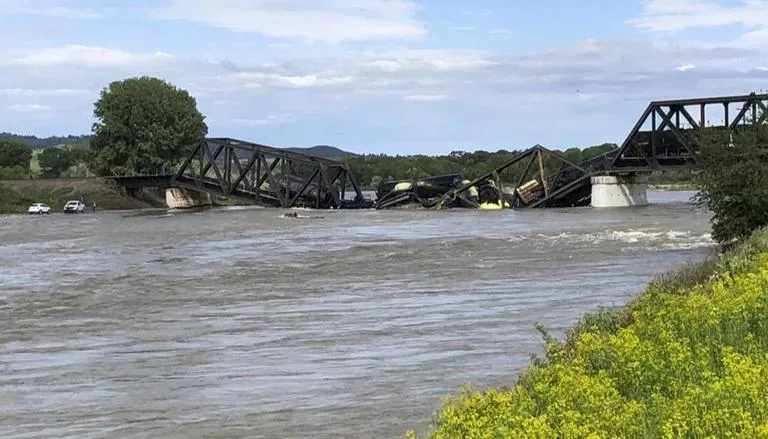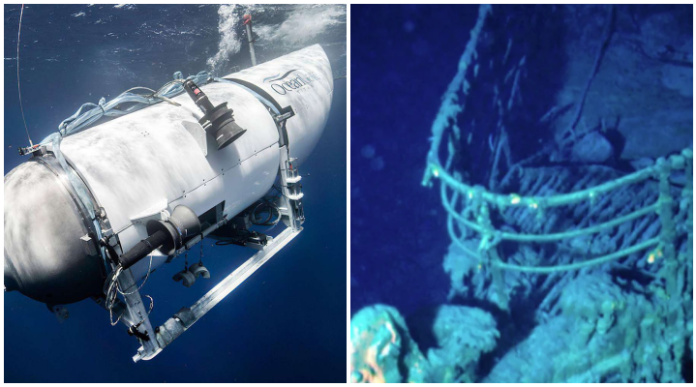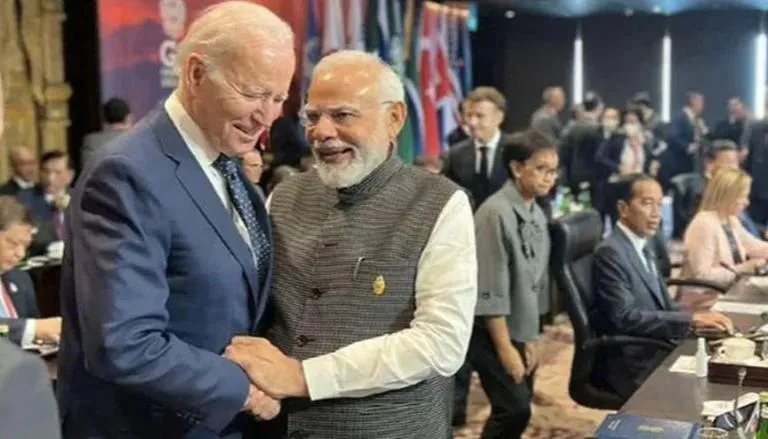The bridge collapsed overnight near Columbus, Montana causing several train cars to be immersed in the Yellowstone River.

Portions of a freight train plunged into the Yellowstone River due to bridge collapse. (Image: AP)
A bridge that crosses the Yellowstone River in Montana collapsed early Saturday, plunging portions of a freight train carrying hazardous materials into the rushing water below.
The train cars were carrying hot asphalt and molten sulfur, Stillwater County Disaster and Emergency Services said. Officials shut down drinking water intakes downstream while they evaluated the danger after the 6 a.m. accident. An Associated Press reporter witnessed a yellow substance coming out of some of the tank cars.
David Stamey, the county’s chief of emergency services, said there was no immediate danger for the crews working at the site, and the hazardous material was being diluted by the swollen river. There were three asphalt cars and four sulfur cars in the river.
The train crew was safe and no injuries were reported, Montana Rail Link spokesman Andy Garland said in a statement. The asphalt and sulfur both solidify quickly when exposed to cooler temperatures, he said.
Railroad crews were at the scene in Stillwater County, near the town of Columbus, about 40 miles (about 64 kilometers) west of Billings. The area is in a sparsely populated section of the Yellowstone River Valley, surrounded by ranch and farmland. The river there flows away from Yellowstone National Park, which is about 110 miles (177 kilometers) southwest.
“We are committed to addressing any potential impacts to the area as a result of this incident and working to understand the reasons behind the accident,” Garland said.
The bridge collapse also took out a fiber-optic cable providing internet service to many customers in the state, the high-speed provider Global Net said. “This is the major fiber route ... through Montana,” a recording on the company’s phone line said Saturday. “This is affecting all Global Net customers. Connectivity will either be down or extremely slow.”
In neighboring Yellowstone County, officials said they instituted emergency measures at water treatment plants due to the “potential hazmat spill” and asked residents to conserve water.
The cause of the collapse is under investigation. The river was swollen with recent heavy rains, but it’s unclear whether that was a factor. The Yellowstone saw record flooding in 2022 that caused extensive damage to Yellowstone National Park and adjacent towns in Montana. Robert Bea, a retired engineering professor at the University of California Berkeley who has analyzed the causes of hundreds of major disasters, said repeated years of heavy river flows provided a clue to the possible cause.
“The high water flow translates to high forces acting directly on the pier and, importantly, on the river bottom,” Bea said. “You can have erosion or scour that removes support from the foundation. High forces translate to a high likelihood of a structural or foundation failure that could act as a trigger to initiate the accident.”
An old highway bridge that paralleled the railroad bridge — together, they were called the Twin Bridges — was removed in 2021 after the Montana Department of Transportation determined it was in imminent danger of falling. It wasn’t immediately clear when the railroad bridge was constructed or when it was last inspected. Bea said investigators would also want to look at whether there was wear or rust in bridge components as well as a record of maintenance, repair and inspections.
Federal Railroad Administration officials were at the scene working with local authorities. “As part of our investigation, we have requested and will thoroughly review a copy of recent bridge inspection reports from the owner for compliance with federal Bridge Safety Standards,” the agency said in a statement Saturday, noting that responsibility for inspections lies with bridge owners.
Kelly Hitchcock of the Columbus Water Users shut off the flow of river water into an irrigation ditch downstream from the collapsed bridge to prevent contents from the tank cars from reaching nearby farmland. The Stillwater County Sheriff’s Office called the group Saturday morning to warn it about the collapse, Hitchcock said.
The U.S. Environmental Protection Agency notes that sulfur is a common element used as a fertilizer as well as an insecticide, fungicide and rodenticide.






For SysAdmin you can use !Sysadmin@lemmy.ml.
For LinuxAdmin you can use !linuxadmin@lemmy.run.
I haven't found one for IT and Helpdesk yet, but I am pretty sure they are out there.